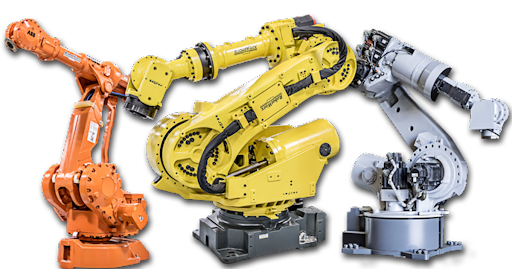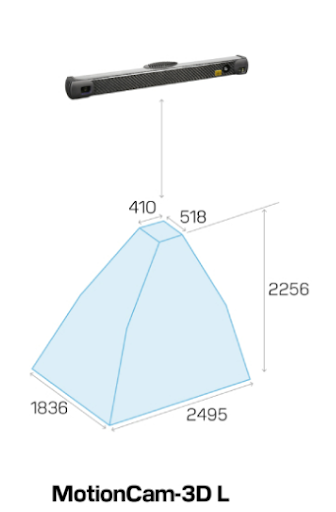What use are industrial robots to me?
The world of industrial robots, once thought of as highly advanced cutting-edge technology is now becoming more and more mainstream. Industrial robots first came to the forefront of technology in the 1950s & 60s with the release of a hydraulic arm manipulator by Unimation, primarily capable of lifting heavy weights. Since this time many developments have occurred making them what they are today. There are many forms of the modern industrial robot but perhaps the most prevalent is the standard 6 axis robot arm, also known as an articulated arm (although articulated arm robots may have more, or less, than 6 axes of motion). which account for 60% of installations worldwide, according to the International Federation of Robots. These robots resemble a human arm and can be pre-programmed to meet various industrial needs.

“A robot can do anything a blind one-armed man can do.”
This quote (origins unknown) is not entirely correct because a blind one-armed man would still have the sense of touch which is lacking from a modern robot. Of course, all 5 of a human’s senses can be mimicked and added to robotics to increase their capabilities in the workplace but these add complexity and with this, of course, cost. The most mimicked human senses by robotics are vision and touch with sound, smell and taste being far less common but still relevant.
Vision systems can be used to give a robot the sense of sight. A camera calibrated to the robot’s environment can generate an image that, with the correct software, can be used to generate positional information aiding many operations such as the picking or placing of parts, inspection, measurement, verification and many more. In recent years 3D cameras have been developed which can add depth information to the traditional 2D data available from a ‘standard’ camera. These cameras open even more advanced applications such as bin picking and 3D assembly and 3D pick and place. Photoneo’s 3D camera shown in the image can rapidly assess parts and deliver a list of what parts are pickable and what the direction of approach should be.


Cameras like these can be mounted on a robot and be moved into position or mounted separately above a picking or placing area so that the required data can them be sent to the robot via a communications protocol.
The sense of touch can be achieved to varying degrees by different sensors. A simple limit switch can be used to register the presence of a part. When present the part triggers the switch that in turn can send a signal to the robot. Other similar sensors such as proximity sensors can also be used in this way. Force sensors are also available which are very useful in automating finishing operations. These sensors use a transducer to convert a force into an electrical signal that then can be used to sense force. There are various ways to configure this type of sensor which can measure a single linear force or more complex forces in 6 degrees of freedom (6DOF.) More recent developments in touch sensing have led to a combination of vision and tactile sensing, GelSight a US company have developed a gel-based sensor that can be used as a ‘fingertip’ for a robot. The sensor consists of a gel pad that conforms to the surface it is pressed against, vision technology is then used to view the gel / surface interface. This image can then be used to provide a lot of high-resolution information on the surface and tactile interaction which can assist in complex object manipulation and performance of dexterous tasks.
It is worth noting that industrial robots do not come as standard with end of arm tooling, which is generally what interfaces with or touches the part, or is the tool to complete an operation. There are many forms of end of arm tool ranging from the most basic perhaps being a simple gripper to highly complex bespoke designs that incorporate many tools and sensors capable of performing highly complex tasks.
The takeaway from all this is that robots are very dumb machines but can be made to perform quite complex tasks with the use of sensors, end of arm tooling and careful thought about the process, what is involved and how can it be performed by a robot with all its limitations.
What can an industrial robots do for my business?
Robots can add value to your business by maximising the use of your labour, thereby helping you do more with less.
Do more with less
Robots used in conjunction with CNC machine tools mean that a single operator skilled in CNC machining can be utilised over many more machines, with automated loading and the correct setup. One operator, who would traditionally be limited to operating one machine, can now operate 5 or more. Of course, the actual numbers depend on the detail but where industrial robots are utilised within machine shops the ratio of skilled operators (who are extremely hard to find and expensive) to machines is dropping with 5 :1 (machines to operators) being quite common.
The health and safety of your workforce is incredibly important both on a humanitarian level but also on an economic level. The use of industrial robots to keep people away from harmful or dangerous operations makes a tremendous amount of sense. Applications like metal finishing are great examples of this. Parts that need deburring, smoothing, surface prepping, polishing or any other finishing operation often require a person to hold the part next to a machine which causes noise, heat, vibration and dust or airborne particulates, all of which can be quite harmful especially when exposure is for an extended length of time. These issues make these processes both undesirable to the workers and highly regulated, meaning workers should be given regular breaks and the levels of acceptable noise, dust vibration need to be regularly checked and reduced where possible. Industrial robots are much more adept at dealing with these problems that humans and so their utilisation makes a lot of sense.
Industrial robots are not very accurate contrary to common belief, but they are repeatable. This means that they will go to the same point in space again and again, even if that point is slightly off target. A typical six axis articulated arm robot with 2-3m reach would have an accuracy of around 1mm but be repeatable to about 0.2mm. This repeatability is excellent for driving quality. A robot will follow the same path again and again when programmed to do so which will mean your parts are processed in exactly the same way again and again thereby minimising variation and driving up consistent quality.
If you have very boring jobs on your shop floor that nobody enjoys doing, then chances are these are the perfect task for a robot. With the employment of good quality workers and their retention becoming harder and harder then the elimination of boring tedious jobs from their ‘must do’ list is very worthwhile.
All these improvements lead to and increase in business efficiency and generally therefore more revenue and profit. In a globally competitive world where everybody is looking to save money on their purchases, efficiency and competitiveness will be of utmost importance. If you would like to discuss further how you could use industrial robots to improve your business please get in touch with A3L today.
Related posts
Robot offline programming
What is offline programming? Robot offline programming (OLP) in essence is the programming of a robo
Belt Grinding Machine Automation
Belt grinding machine automation is used extensively in manufacturing for finishing operations or al
Automated Abrasive Finishing Systems
A3L specialise in delivering robotic and bespoke automated abrasive finishing systems into the UK an